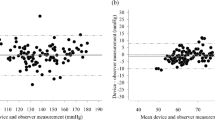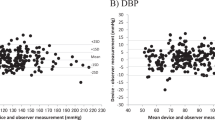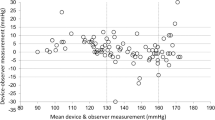Abstract
An appropriate cuff according to the individual's arm circumference is recommended with all blood pressure (BP) monitors. An electronic device for home monitoring has been developed (Visomat Comfort 20/40) that estimates the individual's arm circumference by measuring the cuff filing volume and makes an adjustment of measured BP taking into account the estimated arm circumference. Thus the manufacturer recommends the use of a single cuff for arm circumference 23–43 cm. The device accuracy was assessed using the European Society of Hypertension International Protocol. Simultaneous BP measurements were obtained in 33 adults by two observers (connected mercury sphygmomanometers) four times, sequentially with three measurements taken using the tested device. Absolute device-observer BP differences were classified into ⩽5, ⩽10 and ⩽15 mm Hg zones. For each participant the number of measurements with a difference ⩽5 mm Hg was calculated. The device produced 60/89/97 measurements within 5/10/15 mm Hg respectively for systolic BP, and 72/97/98 for diastolic. Twenty-three subjects had at least two of their systolic BP differences ⩽5 mm Hg and three had no differences ⩽5 mm Hg (for diastolic 27 and 1, respectively). Mean device-observer BP difference (systolic/diastolic) was 3.7±5.6/−1.5±4.7 mm Hg (4.7±4.9/−1.7±4.3 in arm circumference 23–29 cm [39 readings] and 3.1±5.9/−1.4±5.0 in arm 30–34 cm [60 readings], P=NS). In conclusion, the device fulfils the International Protocol requirements and can be recommended for clinical use. Interestingly, the device was accurate using a single cuff in a wide range of arm circumference (23–34 cm). This study provides no information about the device accuracy in larger arms.
This is a preview of subscription content, access via your institution
Access options
Subscribe to this journal
Receive 12 digital issues and online access to articles
$119.00 per year
only $9.92 per issue
Buy this article
- Purchase on Springer Link
- Instant access to full article PDF
Prices may be subject to local taxes which are calculated during checkout

Similar content being viewed by others
References
Pickering TG, Hall JE, Appel LJ, Falkner BE, Graves J, Hill MN et al., Subcommittee of Professional and Public Education of the American Heart Association Council on High Blood Pressure Research. Recommendations for blood pressure measurement in humans and experimental animals: Part 1: blood pressure measurement in humans: a statement for professionals from the Subcommittee of Professional and Public Education of the American Heart Association Council on High Blood Pressure Research. Hypertension 2005; 45: 142–161.
O’Brien E, Asmar R, Beilin L, Imai Y, Mallion JM, Mancia G et al., European Society of Hypertension Working Group on Blood Pressure Monitoring. European Society of Hypertension recommendations for conventional, ambulatory and home blood pressure measurement. J Hypertens 2003; 21: 821–848.
Stergiou G, Mengden T, Padfield PL, Parati G, O’Brien E, Working Group on Blood Pressure Monitoring of the European Society of Hypertension. Self monitoring of blood pressure at home. BMJ 2004; 329: 870–871.
dabl® Educational Trust. Devices for blood pressure measurement. http://www.dableducational.org.Assessed 5 April 2008.
O’Brien E . Review: a century of confusion; which bladder for accurate blood pressure measurement? J Hum Hypertens 1996; 10: 565–572.
Petrie JC, O’Brien ET, Littler WA, de Swiet M, British Hypertension Society. Recommendations on blood pressure measurement. BMJ 1986; 293: 611–615.
Williams B, Poulter NR, Brown MJ, Davis M, McInnes GT, Potter JF et al., British Hypertension Society. Guidelines for management of hypertension: report of the fourth working party of the British Hypertension Society, 2004-BHS IV. J Hum Hypertens 2004; 18: 139–185.
Stolt M, Sjönell G, Aström H, Hansson L . The reliability of auscultatory measurement of arterial blood pressure. A comparison of the standard and a new methodology. Am J Hypertens 1990; 3: 697–703.
O’Brien E, Pickering T, Asmar R, Myers M, Parati G, Staessen J et al., Working Group on Blood Pressure Monitoring of the European Society of Hypertension. Working Group on Blood Pressure Monitoring of the European Society of Hypertension International Protocol for validation of blood pressure measuring devices in adults. Blood Press Monit 2002; 7: 3–17.
Stergiou GS, Malakos JS, Voutsa AV, Achimastos AD, Mountokalakis TD . Home monitoring of blood pressure: limited value in general practice. J Hum Hypertens 1996; 10: 219–223.
Association for the Advancement of Medical Instrumentation. American National Standard: Electronic or Automated Sphygmomanometers. AAMI: Arlington, VA, 1993.
Acknowledgements
This work was funded by a grant from UEBE Medical GmbH Wertheim, Germany.
Author information
Authors and Affiliations
Corresponding author
Rights and permissions
About this article
Cite this article
Stergiou, G., Tzamouranis, D., Nasothimiou, E. et al. Can an electronic device with a single cuff be accurate in a wide range of arm size? Validation of the Visomat Comfort 20/40 device for home blood pressure monitoring. J Hum Hypertens 22, 796–800 (2008). https://doi.org/10.1038/jhh.2008.70
Received:
Revised:
Accepted:
Published:
Issue Date:
DOI: https://doi.org/10.1038/jhh.2008.70
Keywords
This article is cited by
-
Cuff and Bladder: Overlooked Components of BP Measurement Devices in the Modern Era?
American Journal of Hypertension (2012)
-
Accuracy of a single rigid conical cuff with standard-size bladder coupled to an automatic oscillometric device over a wide range of arm circumferences
Hypertension Research (2010)
-
Evaluation of the Omron MX3 Plus monitor for blood pressure measurement in adolescents
European Journal of Pediatrics (2009)



